
If you carry a pistol for personal protection, here are 3 top defensive handgun drills and skills that you need to master.
There’s no shortage of shooting drills that can be used to evaluate and train for concealed carry. There are several reasons for this. Most drills are conceived to focus on an individual or just a few specific skills related to shooting a defensive handgun. This allows you to focus your attention on these individual skills so that you can evaluate your performance and flag specific performance elements that need improvement. Otherwise, drills become more of an overall assessment of your abilities, and it becomes more difficult to identify areas where you might need additional training.
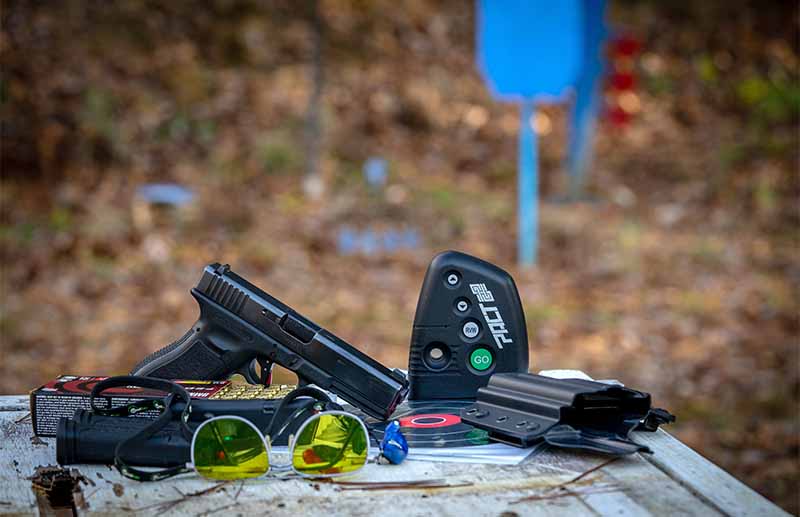
The other reason there are so many defensive handgun drills is because running the same drill over and over can become monotonous and boring. For every specific skill that you want to focus on, there are a wide variety of drills that can be concocted to address them. By working with multiple drills, you not only add enjoyment to training sessions, but you also broaden your overall skill set.
Here are three drills that focus on several specific skills as they relate to the defensive handgun. You’ll notice that with each drill, you start with the handgun in the holster. The reason for this is that your draw or handgun presentation is a very important skill, and you should never pass up an opportunity to get more repetitions.
You’ll also notice that, with these drills, you must shoot 100 percent. In other words, only hits count … because, as we all should already know, hitting is the point of shooting.
As for the resources necessary to conduct these drills, there are a few items that are required. You’ll need some Thompson Target 8-inch Halo targets (item #4610), and some of their self-adhesive Halo targets (item #7042). You could just use 8- and 4-inch circles, but more on that will be discussed in the scoring section of each drill.
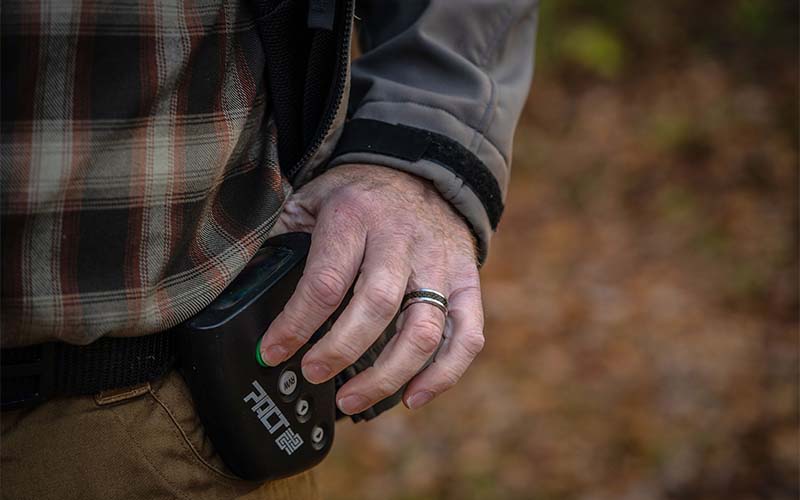
You’re also going to need some target stands and a shot timer. With some ingenuity, you can come up with some target stands—but you’re going to need a shot timer, and PACT’s Club Timer III, at about $130, is hard to beat.
No. 1: The EDC Drill
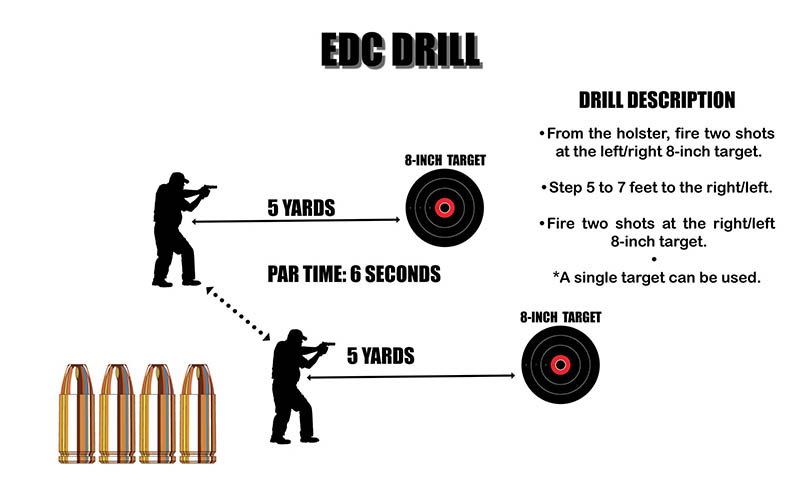
Purpose: When it comes to the practical application of a self-defense handgun, it’s not only about shooting. Moving targets are harder to hit than stationary targets, and similarly, if you’re being assaulted it’s always a good idea to make your attacker alter their path to get to you. The idea behind the EDC drill is to engage the target and then move and engage the target again, if necessary. The target for this drill isn’t excessively small, so it allows you to focus more on the movement and reestablishing a shooting foundation than on pinpoint accuracy.
Resources Required: You’ll need your defensive handgun and a holster. Ideally, you’d use the holster you actually carry your EDC handgun in. It’d also be ideal if you conducted the draw from concealment, because, well, if you ever must use your concealed carry handgun you’ll likely be drawing from concealment. You’ll also need at least one Thompson Target #4610 Halo target and your shot timer.
Drill Conduct: Place a target stand at 5 yards and place one target on the cardboard backer. Next, step back 5 yards from the target and paint an X on the ground; then, take two steps to the right or left and paint another X on the ground. Now, set your shot timer to the delay start mode.
Standing on either the right or left X, on signal, draw and fire two shots at the target. Then, move to the left or right—to the other X—and fire two more shots at the target. Alternatively, you can use two target stands and two targets and engage one target—a different target—from each position.
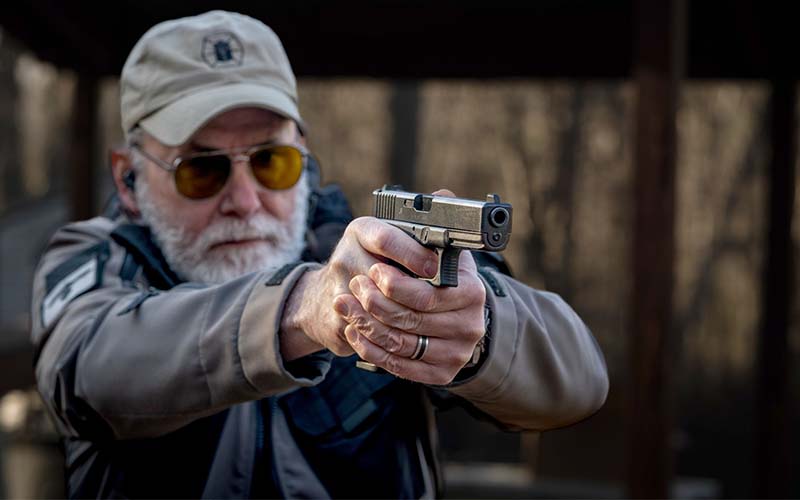
Par Time and Scoring: The par time for this drill is 6 seconds, and you should have four hits inside the target for a passing score. As you progress in skill, you can reduce the size of the target by trying to keep all your shots inside one of the smaller scoring rings. Once you can do this drill within the par time and keep all your shots inside the No. 7 or No. 6 scoring rings, you’ve then found a good balance between speed and accuracy.
No. 2: The Cadence Drill
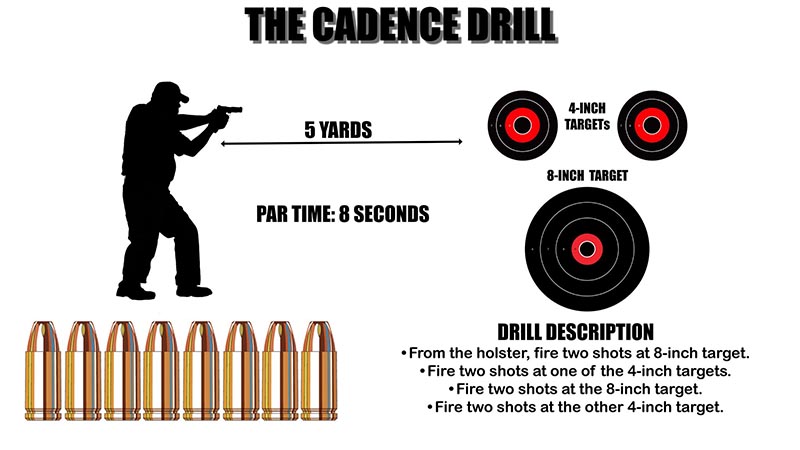
Purpose: When you fire multiple shots at a target with a defensive handgun, you must adjust your shot cadence—the time between shots—so that you’re not shooting too fast or too slow based on the distance to, and size of, the target. This drill helps you identify your shot cadence at different distances and/or for different size targets. This is particularly important if you’re in a situation where the distance to your attacker changes—or if you’re faced with multiple attackers at different distances.
Resources Required: You’ll need your defensive handgun and a holster. If possible, use the holster you carry your EDC handgun in. If you’re comfortable with drawing from concealment, that’s preferred. You’ll also need one target stand, and one Thompson Target #4610 Halo target, two Thompson Target adhesive #7042 Halo targets and your shot timer.

Drill Conduct: Place a target stand at 5 yards and place one 8-inch Halo target and two 4-inch Halo targets on the cardboard backer. Next, step back 5 yards from the target and set your shot timer to the delay start mode. On signal, draw and fire two shots at the large target, two shots at one of the smaller targets, two shots at the large target again and finally, two shots at the other, smaller target.
Par Time and Scoring: The par time for this drill is 8 seconds, and you should have two hits inside each of the smaller targets and four hits inside the larger target. Just as with the EDC drill, as you progress in skill you can add a concealment garment and you can reduce the size of the target by trying to keep all your shots inside one of the smaller scoring rings. The smaller target simulates the larger target at 10 as opposed to 5 yards.
Once you can do this drill within the par time and keep all your shots inside the No. 8 or No. 7 scoring rings on both targets, you’ve then found a good balance between speed and accuracy. Use the shot timers review feature to obtain your split times—the times between shots—and compare the splits on the larger target with those on the smaller targets.
No. 3: The Long Ranger
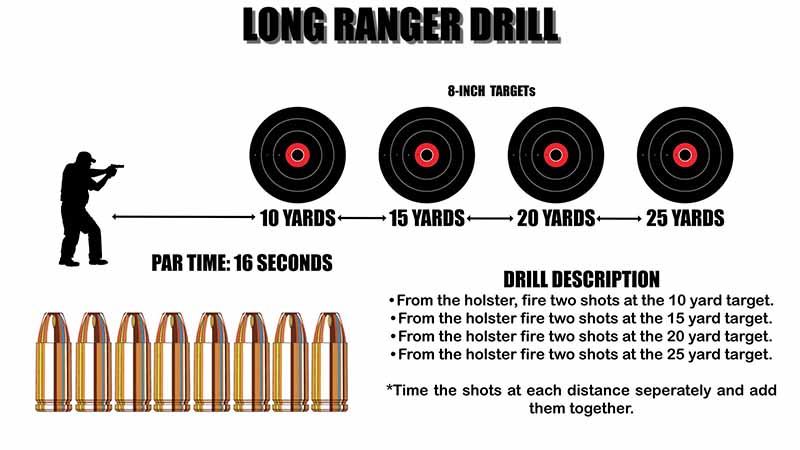
Purpose: The Long Ranger drill is similar to the Cadence Drill because you’ll be firing multiple shots at different distances. The difference is that you’ll not be transitioning between targets under time. The idea with the Long Ranger drill is to develop your ability to engage a single target with multiple shots, up close and at distance.
Resources Required: For this drill, you’re going to need a target stand and a Thompson Target 8-inch Halo target (#4610). Again, and as always, use your everyday carry gun and your concealment holster, with a cover garment if possible. Alternatively, you could use four target stands and four targets. That way you don’t have to move the single target or step back 5 yards after each segment of the drill. As always, you’ll also need your shot timer.
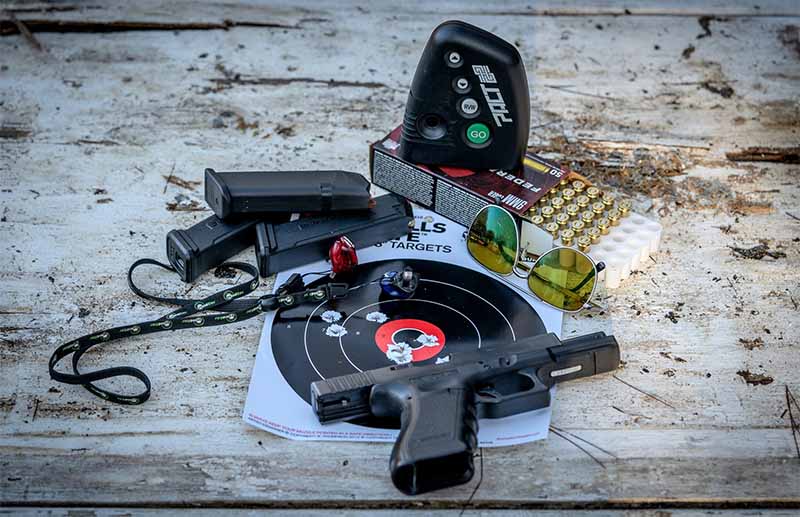
Drill Conduct: Start by standing 10 yards from the target with your shot timer on the delay start mode. At the start signal, draw and fire two rounds. Now, either step back 5 yards or switch to the 15-yard target. Again, and from the holster, at the signal fire two shots at the 15-yard target. You’re going to repeat this exercise again at 20 yards and a final time at 25 yards.
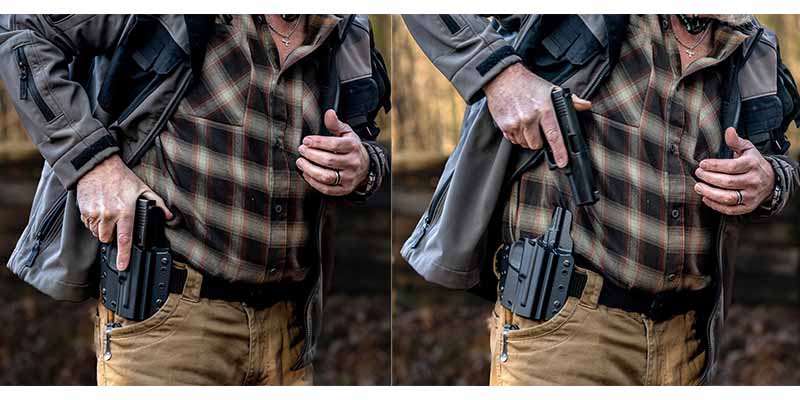
In total, you’ll have fired eight shots and you should’ve recorded the individual engagement and split times for each of the four drill segments. The shot timer will tell you the time it took to fire the first shot on each engagement. It’ll also tell you the time between the first and second shots for each segment. These split times are important for training—you want to make them faster.
Par Time and Scoring: The par time for this drill is 16 seconds, but it’s the sum of the times for each individual engagement. Add them together and they should not exceed 16 seconds. If you stepped back for each separate engagement to a different distance, you should have eight hits in a single target. If you used a different target for each distance, you should have two hits in each target.
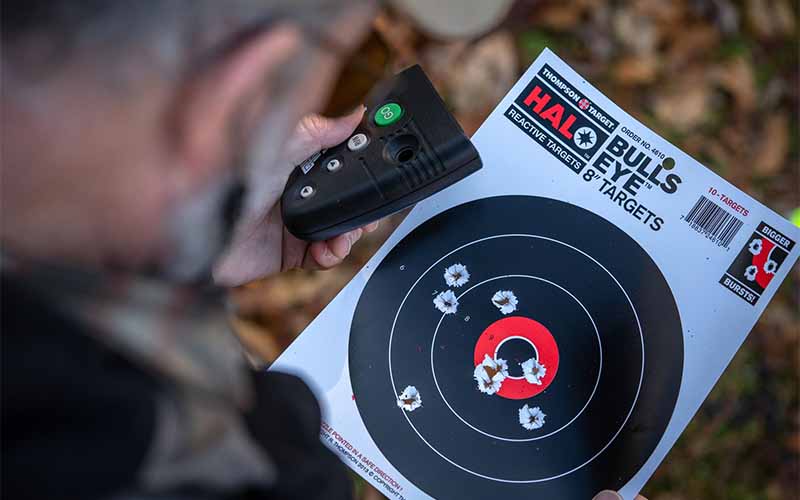
Just as with the EDC drill, as you progress in skill you can add a concealment garment and you can reduce the size of the target by trying to keep all your shots inside a smaller scoring ring. If you can do this drill within the par time and keep all your shots inside the No. 8 or No. 7 scoring rings from each distance, you’ve then found a very good balance between speed and accuracy. This will be hard to do at the 20- and 25-yard distances.
Summary
Remember: With each drill, you’re targeting a specific application of the defensive handgun. Make sure to use your shot timer’s review feature to see what your draw times (the time from the start signal to the first shot) and your split times (the time between each shot) were. These will help you evaluate your performance and optimally help you discover the individual aspects of the drill that you need to practice more.
As always, you should keep a record of your training and performance for future reference. This will provide good information for you on your next range session, and it will also provide a record that you take training with a self-defense handgun seriously, should you ever have to actually use it in a threatening situation. Courts tend to look at things that were not documented as things that never happened.
Editor's Note: This article originally appeared in the 2023 CCW special issue of Gun Digest the Magazine.
More Defensive Handgun Drills:
- Video: Target Transition Training With The Dot Drill
- The Shot Timer And Defensive Handgun Training
- Gun Digest’s 10 Best Shooting Drills And Firearms Training Posts
- MantisX: Simple And Effective Training
- Video: Is A Full-Sized Pistol The Best Training Option?

Next Step: Get your FREE Printable Target Pack
Enhance your shooting precision with our 62 MOA Targets, perfect for rifles and handguns. Crafted in collaboration with Storm Tactical for accuracy and versatility.
Subscribe to the Gun Digest email newsletter and get your downloadable target pack sent straight to your inbox. Stay updated with the latest firearms info in the industry.

![Best Concealed Carry Guns In 2025 [Field Tested] Wilson Combat EDC X9S 1](https://gundigest.com/wp-content/uploads/Wilson-Combat-EDC-X9S-1-324x160.jpg)


![Best 9mm Carbine: Affordable PCCs [Tested] Ruger Carbine Shooting](https://gundigest.com/wp-content/uploads/Ruger-Carbine-Shooting-100x70.jpg)
![Best AR-15: Top Options Available Today [Field Tested] Harrington and Richardson PSA XM177E2 feature](https://gundigest.com/wp-content/uploads/Harrington-and-Richardson-PSA-XM177E2-feature-100x70.jpg)

Kinda sad that not many indoor ranges allow those(so gotta stick to outdoor ones pretty much always). At least there are a couple of events at Gritr’s Shoot House that focus on those(as well as low-light situations), but events aren’t as frequent as I’d like ’em to be…